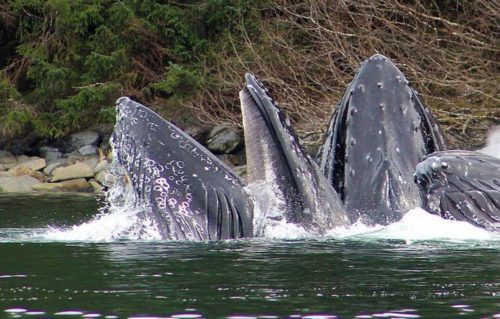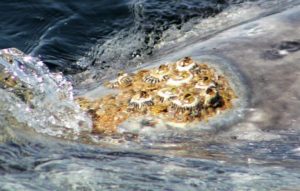One of our recent guests sent an email after her photography trip and asked what the round white marks on the head and ventral pleats in her photos are. In an answer to her musing, I replied it was the scarring from and sometimes a remainder of the barnacles that attach themselves to the whales. Well, this sent me on a pondering parasite quest! I had read a tad about and seen whale lice and barnacles before, but never researched those creatures, which to most (normal) people provoke squirming, an “ick,” or other similar gruff reaction.

It is gray whale season here in beautiful Sitka, Alaska and these amazing cetaceans exhibit some of the largest and most dense populations of parasites of any cetacean species. So, off I went on the google machine to find information to share and add a more complete story for our guests about the creatures we cherish.
Gray whales are more heavily infested with a greater variety of parasites and hitchhikers than any other cetacean. Imagine carrying a load of tourists on your back that can weigh several hundred pounds! Gray whales do this all their lives.

Gray whales have whale lice, but it is not very accurate to name them “lice,” because they are actually amphipods, which are tiny crustaceans that make their livelihood on their host cetaceans. Whale lice are orange-colored patches around the barnacles and in crevices of the whale’s body, such as creases and the mouth line. The relationship between the lice and their host is rather complex; the lice feed on the skin particles shed by the host and on the fluid secreted by the skin lesions they find on the host body, as well as on the algae found in abundance on and around the host’s body. They stay with the cetacean they have chosen as their living habitat for the “ride of a lifetime.” It is believed lice can spread from mother whales to their calves during birth and nursing. These parasites live in large colonies – one large whale can give a home to as many as 7,500 lice at a time! They never leave the host body, which means that they don’t have a free-swimming period in their life. They are born on, live on and die on their host.
The patchy white spots you see on gray whales are barnacles. Grays carry heavy heaps of these freeloaders. The barnacles are just along for the ride, like hitchhikers using the whales for transport while filtering the water for food. They don’t harm the whales or feed on them as true parasites do. Barnacles find the slow-swimming gray whale a perfect ride through nutrient-rich ocean waters. Barnacles don’t serve any obvious advantage to the whales, but they do give helpful lice a place to hang onto the whale without getting washed away. So, barnacles are not parasites, but could perhaps more accurately be described as commensal organisms, for those of you who might care about the distinction. Sorry for the science word bomb!
As I delved ever deeper into the world of the things that are attached to whales, I discovered something even more fascinating: that cetacean lice species specialize in specific cetacean species. That’s a tongue twister! As do barnacles, but I couldn’t fit that into a tongue twister. Turns out lice and barnacles are very picky when it comes to the types of hosts they partner with for life. Some are species-specific while others can be found on multiple species.

I always wondered if those things hanging off the very ends of some humpback whales’ flukes were a form of kelp. Viola! It turns out they are a form of barnacle called a gooseneck barnacle (so not as to bore anyone that’s not its the scientific name). Low and behold, this barnacle attaches itself to other barnacles on the whale, but only to the type of barnacle that only attaches itself to humpback whales. How about that for certain species specificity? My last tongue twister!
Hope you didn’t get the creepy crawlies!
#whales #whalewatching #whalephotography #hydrophone #sitkaalaska #bubblenetfeeding #wildlifetour